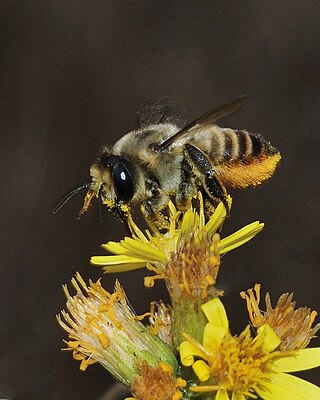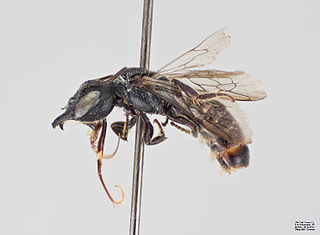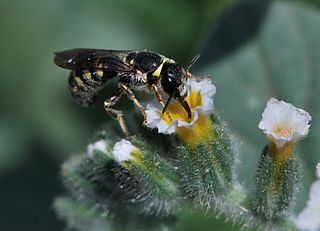
Megachilidae is a cosmopolitan family of mostly solitary bees. Characteristic traits of this family are the restriction of their pollen-carrying structure to the ventral surface of the abdomen, and their typically elongated labrum. Megachilid genera are most commonly known as mason bees and leafcutter bees, reflecting the materials from which they build their nest cells ; a few collect plant or animal hairs and fibers, and are called carder bees, while others use plant resins in nest construction and are correspondingly called resin bees. All species feed on nectar and pollen, but a few are kleptoparasites, feeding on pollen collected by other megachilid bees. Parasitic species do not possess scopae. The motion of Megachilidae in the reproductive structures of flowers is energetic and swimming-like; this agitation releases large amounts of pollen.

The genus Megachile is a cosmopolitan group of solitary bees, often called leafcutter bees or leafcutting bees; it also includes the called resin bees and mortar bees. While other genera within the family Megachilidae may chew leaves or petals into fragments to build their nests, certain species within Megachile neatly cut pieces of leaves or petals, hence their common name. This is one of the largest genera of bees, with more than 1500 species in over 50 subgenera. The alfalfa leafcutter bee is managed on a commercial scale for crop pollination, and has been introduced by humans to various regions around the world.

Anthidium manicatum, commonly called the European wool carder bee, is a species of bee in the family Megachilidae, the leaf-cutter bees or mason bees.
Anthidium montivagum is a species of bee in the family Megachilidae, the leaf-cutter, carder, or mason bees.
Anthidium dammersi is a species of bee in the family Megachilidae, the leaf-cutter, carder, or mason bees.

Hoplitis anthocopoides is a species in the family Megachilidae, in the order Hymenoptera . The distribution range of Hoplitis anthocopoides includes Africa, Europe, Northern Asia, and North America.

Lithurgopsis is a genus of northern cactus woodborers in the family Megachilidae. There are at least nine described species in Lithurgopsis.

Ashmeadiella is a genus of bees in the family Megachilidae. There are more than 60 described species in Ashmeadiella.

Hoplitis is a genus of bees in the family Megachilidae. There are more than 380 described species in Hoplitis.
Chelostoma californicum is a species of bee in the family Megachilidae. It is found in Central America and North America.
Hoplitis producta is a species of bee in the family Megachilidae.
Trachusa larreae is a species of hymenopteran in the family Megachilidae. It is found in Central America and North America.

Brachynomadini is a tribe of cuckoo bees in the family Apidae. There are at least 5 genera and 20 described species in Brachynomadini.

Chelostoma campanularum, or the harebell carpenter bee, is a species of hymenopteran in the family Megachilidae. It is found in Europe and Northern Asia and North America.
Hoplitis bullifacies is a species of bee in the family Megachilidae. It is found in North America.

Chelostoma philadelphi is a species of hymenopteran in the family Megachilidae. It is found in North America.

Protosmia is a genus of subgenus Chelostomopsis in the family Megachilidae. There are more than 30 described species in Protosmia.

Chelostoma rapunculi is a species of bee in the family Megachilidae. It is found in Europe and Northern Asia and North America.

Ochreriades is a genus within Megachilidae. This taxon has been considered the sister lineage "to a clade consisting of the “core” Osmiini, the tribe Megachilini and the genera Pseudoheriades and Afroheriades."
Stenosmia tagmouta is a species of bee, first discovered in 1991. No subspecies are listed in the Catalogue of Life.











